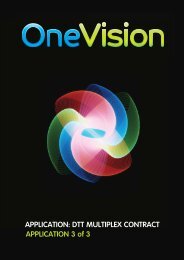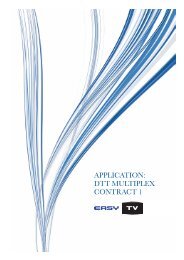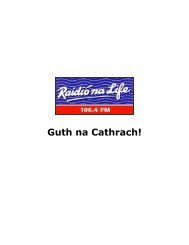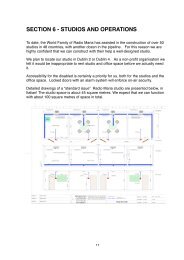Digital Radio for Ireland: Competing Options, Public Expectations - BCI
Digital Radio for Ireland: Competing Options, Public Expectations - BCI
Digital Radio for Ireland: Competing Options, Public Expectations - BCI
You also want an ePaper? Increase the reach of your titles
YUMPU automatically turns print PDFs into web optimized ePapers that Google loves.
<strong>Digital</strong> One ‐ a joint venture, backed by Global <strong>Radio</strong> (the largest British commercial radio company) <br />
and Arqiva (a company which provides telecommunications infrastructure and broadcast transmission <br />
facilities in the UK. Its main customers are broadcasters and mobile phone network operators, and its <br />
main asset is a network of over 1,000 radio and television transmission sites). It operates the largest <br />
DAB digital radio network in the world and is pioneering the role of digital radio in the commercial <br />
world. It is committed to the long‐term promotion of digital radio in the UK and stimulating the <br />
market is part of its licence remit. <br />
<br />
<strong>Digital</strong> radio ‐ <strong>Digital</strong> is a way of transmitting sound and pictures as computerized bits of in<strong>for</strong>mation. <br />
This takes up much less space in the airwaves (bandwidth) than the traditional (analogue) system, so <br />
there is room <strong>for</strong> more radio stations and other features. <br />
<br />
DMB ‐ (<strong>Digital</strong> Multimedia Broadcasting) is an audiovisual update of the DAB system. It’s a method <strong>for</strong> <br />
the digital transmission of multimedia signals (especially video services) <strong>for</strong> mobile reception. <br />
<br />
Downloads ‐ Transfer of data from a server to an individual computer's hard disk. You can use your <br />
browser or an FTP (File Transfer Protocol) program to download files to your computer. A music <br />
download refers to the transferring of a music file from an internet‐facing computer or website to a <br />
user's local computer. <br />
<br />
DRM ‐ (<strong>Digital</strong> <strong>Radio</strong> Mondiale) was developed to provide near‐FM quality sound on AM and it also <br />
has capacity to broadcast additional data and text. <br />
<br />
DTT – (<strong>Digital</strong> Terrestrial Television System) broadcast entirely over earthbound circuits. DTT signals <br />
are broadcast over essentially the same media as the older analogue terrestrial TV signals. DTT <br />
provides a clearer picture and superior sound quality when compared to analogue TV, with less <br />
interference and offers far more channels, thus providing the viewer with a greater variety of <br />
programmes. <br />
<br />
DTSB ‐ <strong>Digital</strong> Terrestrial Sound Broadcasting stands <strong>for</strong> digital sound systems in the terrestrial <br />
Broadcasting Service. <br />
<br />
DVB – (<strong>Digital</strong> Video Broadcasting) broadcasts programmes to everyone in the same way as traditional <br />
broadcasting; but the user can also download on‐demand type audio content that is not a strictly live <br />
transmission. <br />
<br />
EBU – (the European Broadcasting Union) is a confederation of 75 broadcasting organisations from 56 <br />
countries, and 43 associate broadcasters from a further 25. Members are radio and television <br />
companies, most of which are government‐owned public service broadcasters or privately owned <br />
stations with public missions. <br />
<br />
EPG – (Electronic programme Guide) is an on‐screen guide to scheduled radio or television <br />
programmes, allowing a viewer/listener to navigate, select, discover and record content by time, title, <br />
channel, genre, etc. <br />
EUREKA 147 – a technical body initiated under the Eureka R&D development programme. The <br />
consortium comprising prominent European public broadcasters, the EBU and technology <br />
development institutes developed the original DAB (<strong>Digital</strong> Audio Broadcasting) System. The Eureka <br />
Project 147 was established in 1987, with funding from the European Commission, to develop a <br />
system <strong>for</strong> the broadcasting of audio and data to fixed, portable or mobile receivers. The technical <br />
development envisaged a digitalization of broadcasting distribution, which would produce improved <br />
reception compared to FM, particularly mobile reception, and with the potential to offer additional <br />
91






